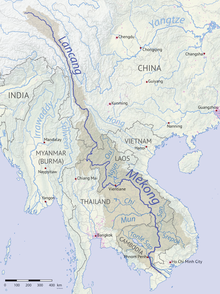Energy in Laos
[5] This move resulted from the government's intention to become the "battery of Southeast Asia", as Laos currently exports an estimated two-thirds of its hydropower.According to the Strategic Environmental Assessment (SEA) of the MRC, if the proposed dams are built, they will generate 15,000 MW of power, which is projected to fill 8% of the regional demand by 2025.[12]: 221 The US$3.8 billion (£2.4bn) proposed hydroelectric Xayaburi Dam has caused tension among Mekong region countries: Laos, Vietnam, Cambodia, and Thailand.[14] Finnish engineering firm Pöyry supported the Lao government's hydropower construction proposal by arguing that no international agreement is needed.[9] The aim was to supply electricity mainly to Thailand by a Thai company and to provide export income to the government of Laos.[18] The Lower Mekong Basin provides a wide range of benefits: drinking water, freshwater food supplies, biodiversity hotspots, agricultural irrigation, transport, and industrial uses (such as hydropower development).The Tonle Sap region of Cambodia, the largest freshwater lake in Southeast Asia, is critical for food security as it provides areas for agriculture and aquaculture in the surrounding wetlands and flooded forests.Generally, the development of a hydropower dam results in altered flow patterns and creates a large physical barrier, thus disrupting the fish and their breeding habitats within the river.[19][20] With the addition of more hydropower dams, local fisheries must adapt to different flow conditions and be prepared for unexpected floods with the potential to wash away assets.A report by the International Center for Environmental Management suggest, "current nutrient load will be reduced by seventy-five percent by 2030" if all proposed dams are built.A block to nutrient-carrying sediment sets off a chain reaction that will inevitability impact all nations downstream, lowering food security and putting millions of livelihoods at risk.Over the last few years, the development of hydropower dams have caused a 10–20% population loss while during a period of 2001–2003, the Thai-Lao border showcased a 50% catch decrease, greatly affecting local communities and their livelihood.

energyelectricitycoal-fired power stationHongsa DistrictSainyabuli ProvinceligniteKaleum DistrictLa Mam Districtfossil fuelsList of power stations in LaosMekong River CommissionMekonghydropowerInternational Riversforeign exchange reservesXayaburi DamPöyryCambodiaVietnamU.S. Secretary of StateHillary Clintonrenewable energySoutheast AsiaMyanmarThailandTibetan PlateauKhorat PlateauTonle Sap BasinMekong Deltafood securityaquaculturefish migrationsedimentflood controlirrigationhydrologyElectricite du LaosGlow EnergysubsidiaryGDF SuezLao Holding State EnterpriseNam Theun 2 Power CompanyEconomy of LaosVoima (newspaper)University of Washington PressarticlesHistoryPeoplingKhun BoromLao peopleTai peoplesLan XangVat PhouLuang PhrabangVientianeChampasakMuang PhuanFrench protectorateJapanese invasionJapanese puppet stateLao IssaraKingdom of LaosIndochina WarsHo Chi Minh trailPathet LaoLaotian Civil WarVietnamese invasionNeutralityHistory until 1945History since 1945Insurgency2007 coup attemptGeographyDeforestationEcoregionsPhou BiaRiversProtected areasWildlifeWorld Heritage SitesPoliticsAdministrative divisionsConstitutionElectionsForeign relationsGeneral SecretaryHuman rightsLGBT rightsLaw enforcementMilitaryNational AssemblyPresidentPolitical partiesVice PresidentPrime MinisterEconomyAgricultureCentral bankKip (currency)FishingStock exchangeTelecommunicationsTourismTrade unionsTransportDemographicsEducationEthnic groupsHealthCOVID-19LanguageProstitutionReligionSex traffickingCultureAnthemCuisineDramatic artsEmblemFestivalsLiteraturePublic holidaysSportsOutlineEnergy in Asia Sovereign states